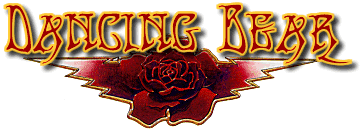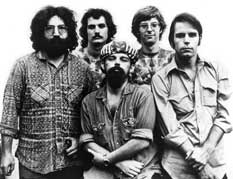A
brief history of the Grateful Dead
Rock's longest,
strangest trip, the Grateful Dead were the psychedelic era's most
beloved musical ambassadors as well as its most enduring survivors,
spreading their message of peace, love and mind-expansion across
the globe throughout the better part of three decades. The object
of adoration for popular music's most fervent and celebrated fan
following — the Deadheads, their numbers and devotion legendary
in their own right — they were the ultimate cult band, creating
a self-styled universe all their own; for the better part of their
career orbiting well outside of the mainstream, the Dead became
superstars solely on their own terms, tie-dyed pied pipers whose
epic, free-form live shows were rites of passage for an extended
family of listeners which knew no cultural boundaries.
The roots of
the Grateful Dead lie with singer/songwriter Jerry Garcia, a longtime
bluegrass enthusiast who began playing the guitar at age 15. Upon
relocating to Palo Alto, California in 1960, he soon befriended
Robert Hunter, whose lyrics later graced many of Garcia's most famous
melodies; in time, he also came into contact with aspiring electronic
music composer Phil Lesh. By 1962, Garcia was playing banjo in a
variety of local folk and bluegrass outfits, two years later forming
Mother McCree's Uptown Jug Champions with guitarist Bob Weir and
keyboardist Ron "Pigpen" McKernan; in 1965, the group was renamed
the Warlocks, their line-up now additionally including Lesh on bass
as well as Bill Kreutzmann on drums.
The Warlocks
made their electric debut that July; Ken Kesey soon tapped them
to become the house band at his notorious Acid Tests, a series of
now-legendary public LSD parties and multimedia "happenings" mounted
prior to the drug's criminalization. As 1965 drew to its close,
the Warlocks rechristened themselves the Grateful Dead, the name
taken from an Egyptian prayer discovered in a dictionary by Garcia;
bankrolled by chemist/LSD manufacturer Owsley Stanley, the band
members soon moved into a communal house situated at 710 Ashbury
Street in San Francisco, becoming a fixture on the local music scene
and building a large fanbase on the strength of their many free
concerts.
Signing to MGM,
in 1966 the Dead also recorded their first demos; the sessions proved
disastrous, and the label dropped the group a short time later.
As 1967 mutated into the Summer of Love, the Dead emerged as one
of the top draws on the Bay Area music scene, honing an eclectic
repertoire influenced by folk, country and the blues while regularly
appearing at top local venues including the Fillmore Auditorium,
the Avalon Ballroom and the Carousel.
In March of
1967 the Dead issued their self-titled Warner Bros. debut LP, a
disappointing effort which failed to recapture the cosmic sprawl
of their live appearances; after performing at the Monterey Pop
Festival, the group expanded to a six-piece with the addition of
second drummer Mickey Hart. Their follow-up, 1968's Anthem of the
Sun, fared better in documenting the free-form jam aesthetic of
their concerts, but after completing 1969's Aoxomoxoa, their penchant
for time-consuming studio experimentation left them over $100,000
in debt to the label. The Dead's response to the situation was to
bow to the demands of fans and record their first live album, 1969's
Live/Dead; highlighted by a rendition of Garcia's "Dark Star" clocking
in at over 23 minutes, the LP succeeded where its studio predecessors
failed in capturing the true essence of the group in all of their
improvisational, psychedelicized glory.
Live Dead was
followed by a pair of classic 1970 studio efforts, Workingman's
Dead and American Beauty; recorded in homage to the group's country
and folk roots, the two albums remained the cornerstone of the Dead's
live repertoire for years to follow, with its most popular songs
— "Uncle John's Band," "Casey Jones," "Sugar Magnolia" and "Truckin'"
among them — becoming major favorites on FM radio.
Despite increasing
radio airplay and respectable album sales, the Dead remained first
and foremost a live act, and as their popularity grew across the
world they expanded their touring schedule, taking to the road for
much of each year. As more and more of their psychedelic-era contemporaries
ceased to exist, the group continued attracting greater numbers
of fans to their shows, many of them following the Dead across the
country; dubbed "Deadheads," these fans became notorious for their
adherence to tie-dyed fashions and excessive drug use, their travelling
circus ultimately becoming as much the focal point of concert dates
as the music itself. Shows were also extensively bootlegged, and
not surprisingly the Dead closed out their Warners contract with
back-to-back concert LPs — a 1971 eponymous effort and 1972's Europe
'72. The latter release was the final Dead album to feature Pigpen
McKernan, a heavy drinker who died of liver failure on March 8,
1973; his replacement was keyboardist Keith Godchaux, who brought
with him wife Donna Jean to sing backing vocals.
1973's Wake
of the Flood was the first release on the new Grateful Dead Records
imprint; around the time of its follow-up, 1974's Grateful Dead
from the Mars Hotel, the group took a hiatus from the road to allow
its members the opportunity to pursue solo projects. After returning
to the live arena with a 1976 tour, the Dead signed to Arista to
release Terrapin Station, the first in a series of misguided studio
efforts that culminated in 1980's Go to Heaven, widely considered
the weakest record in the group's catalog — so weak, in fact, that
they did not re-enter the studio for another seven years.
The early Eighties
was a time of considerable upheaval for the Dead — the Godchauxs
had been dismissed from the line-up in 1979, with Keith dying in
a car crash on July 23, 1980. (His replacement was keyboardist Brent
Mydland.) After a pair of 1981 live LPs, Reckoning and Dead Set,
the group released no new recordings until 1987, focusing instead
on their touring schedule — despite the dearth of new releases,
the Dead continued selling out live dates, now playing to audiences
which spanned generations. As much a cottage industry as a band,
they travelled not only with an enormous road crew but also dozens
of friends and family members, many of them Dead staffers complete
with health insurance and other benefits.
Still, the Dead
were widely regarded as little more than an enduring cult phenomenon
prior to the release of 1987's In the Dark; their first studio LP
since Go to Heaven, it became the year's most unlikely hit when
the single "Touch of Grey" became the first-ever Dead track to reach
the Top Ten on the pop charts. Suddenly their videos were in regular
rotation on MTV, and virtually overnight the ranks of the Deadheads
grew exponentially, with countless new fans flocking to the group's
shows. Not only did concert tickets become increasingly tough to
come by for longtime followers, but there were also more serious
repercussions — the influx of new fans shifted the crowd dynamic
considerably, and once-mellow audiences became infamous not only
for their excessive drug habits but also for their violent encounters
with police.
Other troubles
plagued the Dead as well: in July 1986, Garcia — a year removed
from a drug treatment program — lapsed into near-fatal diabetic
coma brought on by his contined substance abuse problems, regaining
consciousness five days later. His health remained an issue in the
years which followed, but the Dead spent more time on tour than
ever, with a series of dates with Bob Dylan yielding the live album
Dylan and the Dead. Their final studio effort, Built to Last, followed
in 1989. Tragedy struck in October of that year when a fan died
after breaking his neck outside of a show at the New Jersey Meadowlands;
two months later, a 19-year-old fan on LSD also died while in police
custody at the Los Angeles Forum. As ever, the Dead themselves were
also not immune to tragedy — on July 26, 1990, Mydland suffered
a fatal drug overdose, the third keyboardist in group history to
perish; he was replaced not only by ex-Tubes keyboardist Vince Welnick
but also by satellite member Bruce Hornsby, a longtime fan who frequently
toured with the group.
In the autumn
of 1992 Garcia was again hospitalized with diabetes and an enlarged
heart, forcing the Dead to postpone their upcoming tour until year's
end; he eventually returned to action looking more fit than he had
in years. Still, few were surprised when it was announced on August
9, 1995 that Garcia had been found dead in his room at a substance
abuse treatment facility in Forest Knolls, California; the 53-year-old's
death was attributed to a heart attack.
While Garcia's
death spelled the end of the Dead as a continuing creative entity,
the story was far from over. As the surviving members disbanded
to plot their next move, the band's merchandising arm went into
overdrive — in addition to Dick's Picks, a series of archival releases
of classic live material, licensed products ranging from Dead t-shirts
to sporting goods to toys flooded the market. Plans were also announced
to build Terrapin Station, an interactive museum site. In 1996,
Weir and Hart mounted the first Furthur festival, a summer tour
headlined by their respective bands Ratdog and Mystery Box; in 1998,
they also reunited with Lesh and Hornsby to tour as the Other Ones.
In spirit if not in name, the Grateful Dead's trip continues on.
— Jason Ankeny, © allmusic.com
|



![]()
.jpg) This site uses NO cookies!
This site uses NO cookies!



.jpg) This site uses NO cookies!
This site uses NO cookies!
